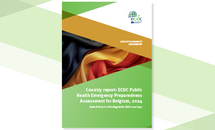Country report: ECDC Public Health Emergency Preparedness Assessment for Belgium, 2024 - Under Article 8 of the Regulation (EU) 2022/2371
As stated in Article 8 of the Regulation (EU) 2022/2371 on Serious Cross-Border Threats to Health (SCBTH), ECDC has the responsibility, in coordination with relevant Union agencies and bodies, to conduct Public Health Emergency Preparedness Assessments (PHEPA) of all 30 European Union and European Economic Area (EU/EEA) countries every three years regarding the state of implementation of their national prevention, preparedness and response planning. This assessment is based on the 16 capacities included in the template to be used by countries when providing information on their prevention, preparedness and response planning in accordance with Article 7 of the SCBTH regulation. The aim of the PHEPA is to improve prevention, preparedness and response planning in EU/EEA countries through the implementation of evidence-based recommendations following individual country assessments. Within nine months of the receipt of the ECDC assessment report, if applicable, countries are requested to provide an action plan addressing the proposed recommendations of the assessment.
This report presents the findings and recommendations of the first assessment in the three-year programme conducted in Belgium. This involved a desk review of relevant documents, followed by a five-day mission conducted from 13 to 17 May 2024. As per the established assessment process, of the 16 capacities included in the Article 7 (SCBTH) self-assessment template, the ECDC-led team assessed five capacities in depth and validated Belgium’s responses to the Article 7 questions for the remaining capacities. The five capacities assessed in depth were Capacity 3 – Laboratory; Capacity 4 – Surveillance; Capacity 6 – Health Emergency Management; Capacity 10 – Zoonotic diseases and threats of environmental origin, including those due to the climate; and Capacity 12 – antimicrobial resistance (AMR) and healthcare-associated infections (HAIs).





